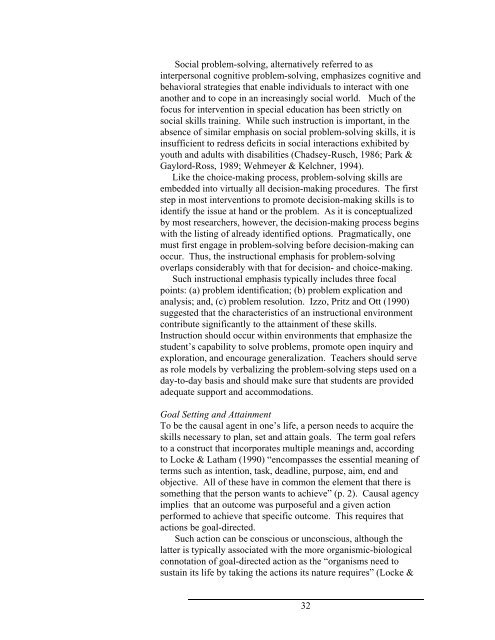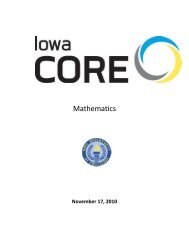The Arc's Self-Determination Scale: Procedural Guidelines
The Arc's Self-Determination Scale: Procedural Guidelines
The Arc's Self-Determination Scale: Procedural Guidelines
Create successful ePaper yourself
Turn your PDF publications into a flip-book with our unique Google optimized e-Paper software.
Social problem-solving, alternatively referred to as<br />
interpersonal cognitive problem-solving, emphasizes cognitive and<br />
behavioral strategies that enable individuals to interact with one<br />
another and to cope in an increasingly social world. Much of the<br />
focus for intervention in special education has been strictly on<br />
social skills training. While such instruction is important, in the<br />
absence of similar emphasis on social problem-solving skills, it is<br />
insufficient to redress deficits in social interactions exhibited by<br />
youth and adults with disabilities (Chadsey-Rusch, 1986; Park &<br />
Gaylord-Ross, 1989; Wehmeyer & Kelchner, 1994).<br />
Like the choice-making process, problem-solving skills are<br />
embedded into virtually all decision-making procedures. <strong>The</strong> first<br />
step in most interventions to promote decision-making skills is to<br />
identify the issue at hand or the problem. As it is conceptualized<br />
by most researchers, however, the decision-making process begins<br />
with the listing of already identified options. Pragmatically, one<br />
must first engage in problem-solving before decision-making can<br />
occur. Thus, the instructional emphasis for problem-solving<br />
overlaps considerably with that for decision- and choice-making.<br />
Such instructional emphasis typically includes three focal<br />
points: (a) problem identification; (b) problem explication and<br />
analysis; and, (c) problem resolution. Izzo, Pritz and Ott (1990)<br />
suggested that the characteristics of an instructional environment<br />
contribute significantly to the attainment of these skills.<br />
Instruction should occur within environments that emphasize the<br />
student’s capability to solve problems, promote open inquiry and<br />
exploration, and encourage generalization. Teachers should serve<br />
as role models by verbalizing the problem-solving steps used on a<br />
day-to-day basis and should make sure that students are provided<br />
adequate support and accommodations.<br />
Goal Setting and Attainment<br />
To be the causal agent in one’s life, a person needs to acquire the<br />
skills necessary to plan, set and attain goals. <strong>The</strong> term goal refers<br />
to a construct that incorporates multiple meanings and, according<br />
to Locke & Latham (1990) “encompasses the essential meaning of<br />
terms such as intention, task, deadline, purpose, aim, end and<br />
objective. All of these have in common the element that there is<br />
something that the person wants to achieve” (p. 2). Causal agency<br />
implies that an outcome was purposeful and a given action<br />
performed to achieve that specific outcome. This requires that<br />
actions be goal-directed.<br />
Such action can be conscious or unconscious, although the<br />
latter is typically associated with the more organismic-biological<br />
connotation of goal-directed action as the “organisms need to<br />
sustain its life by taking the actions its nature requires” (Locke &<br />
32
















